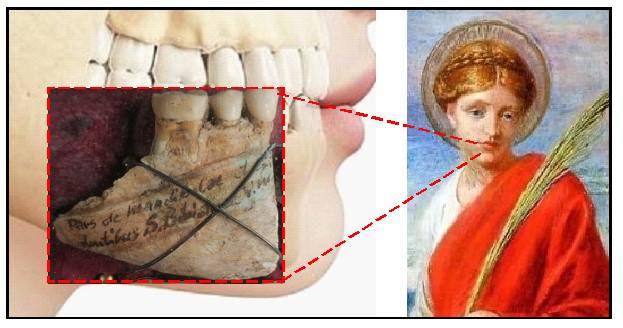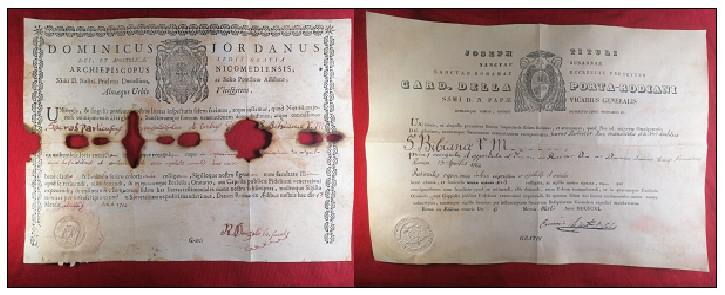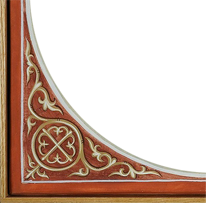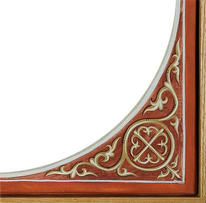
Saint Bibiana of Rome, Virgin and Martyr. In the year 363 A.D., Julian the Apostate was elevated to the position as Apronianus Governor of Rome. St. Bibiana and her family would experience the full weight of Imperial Roman “justice” imposed personally by directives from this violent tyrant. She and her sister, her sister, St. Demetria, were the daughters of deeply committed Christians, St. Flavian, a Roman knight, and St. Dafrosa, his wife.
St. Bibiana’s father, Flavian, was tortured and immediately sent into exile where, shortly after his arrival from Rome, died from the wounds inflicted upon his body. Her mother, Dafrosa, was summarily executed by means of beheading. In the aftermath of their parents’ martyrdom, all of their earthly possessions were confiscated, leaving St. Bibiana and Demetria destitute. For a short period, the Pagan Roman State permitted them to remain in their family home, until they, too, would be brought to trial for their Faith. Anticipating their inevitable death at the hands of the state, both siblings spent much of their limited time on earth in fasting and prayer.
Apronianus, seeing that experiencing hunger and destitution had no effect upon them, summoned the sisters to stand trial. After formally refusing to renounce her Christian Faith, St. Demetria abruptly fell dead at the feet of the tyrant. As punishment, St. Bibiana was placed in the hands of a notoriously wicked woman, Rufina, who in endeavored in vain to seduce her. Infuriated at her inability beak her will, Rufina resorted to assaulting St. Babiana with violent beatings. This action failed in yet another futile attempt at “persuasion.” Despite the horrible sufferings she endured, the young woman remained faithful to Christ Jesus.
Enraged at the steadfastness of her faith, Apronianus ordered Bibiana’s death sentence to be carried out immediately. Shortly after abruptly being led away to the site of her execution, she was first stripped of her clothing and tied to a stone pillar. Once firmly secured, two alternating executioners armed employing leather whips, tied at the with ends heavy lead plummets (resembling 2 cm long dumbells), Bibina was flogged death.
Two days after her murder a priest, named John, buried Bibiana’s remains next her mother and sister
at their home. The house was later transformed into a church. Livonia’s All Saints Shrine at Sacred Heart Byzantine Catholic Church is greatly honored to include relics from her mandible and teeth (seen on page 1.)
The earliest mention from an authentic historical authority of Saint Bibiana (Vibiana / Vivian), occurs in the "Liber Pontificalis" containing the biography of Pope Simplicius (468-483). It states that this pontiff: "consecrated a Basilica of the Holy Martyr Bibiana, which contained her body, near the 'Palatium Licinianum'." This ancient basilica dedicated to St. Babiana is still in existence. In the Western Church, she is popularly venerated as “St. Vivian.”

Two Documents of Authenticity of Saint Babiana’s Relics (Mandible and Teeth) Preserved at Sacred Heart’s All Saints Shrine
Previous(Fire-Damaged) Document of Authenticity Issuance Date: April 13, 1764 (above, left); Newest Document of Authenticity Issuance Date: March 6, 1811 (above, right).
According to an ancient, but not documented tradition, the church was built in 363 A.D. by the Roman matron Olimpina (or Olimpia) on the house where, during the persecution of emperor Julian the Apostste (361-363), Bibiana, her mother, Dafrosa, and her sister, Demetria, would have suffered their martyrdom. Her father St. Flavian of Montefiascone, had been exiled and martyred in a place called ad Aquas Taurinas (perhaps the present day Montefiascone). The church was erected in the area of the Horti Liciniani, not far from the nymphaeum. It is usually known as Temple of Minerva Medica. Nearby, there was an ancient cemetery known as ad ursum pileatum.
According to the Liber Pontificalis the church was erected in 467 A.D. under the pontificate of Pope Simplicius. Pope Leo II (682-683) moved the relics of the Martyrs: Saints Simplicius, Faustina and Viatrix from the Generosa Catacombs. The same pope constructed Tuxta Sanctam Vivianam a church consecrated to honor Saint Paul, whose structure no longer exists. That church was eventually rebuilt by Pope Honorius III in 1224 A.D.
The present facade was designed and built by then 26-year-old Gian Lorenzo Bernini from 1624 to 1626, was commissioned by Pope Urban VIII. The columns lining the nave, nonetheless, are remnants from the original fifth-century church.
The church houses a statue of the titular saint, also by Bernini (1626). It features an image of St. Bibiana holding the palm leaf of martyrs, standing next to the column to which she was to be martyred.
The bodies of St Bibiana (Viviana or Vibiana), her mother St. Dafrosa and her sister St. Demetria were discovered inside a third-century sarcophagus, and now rest inside an alabaster urn under the main altar. The column just inside the church is believed to have been the used during St. Bibiana’s martyrdom.




